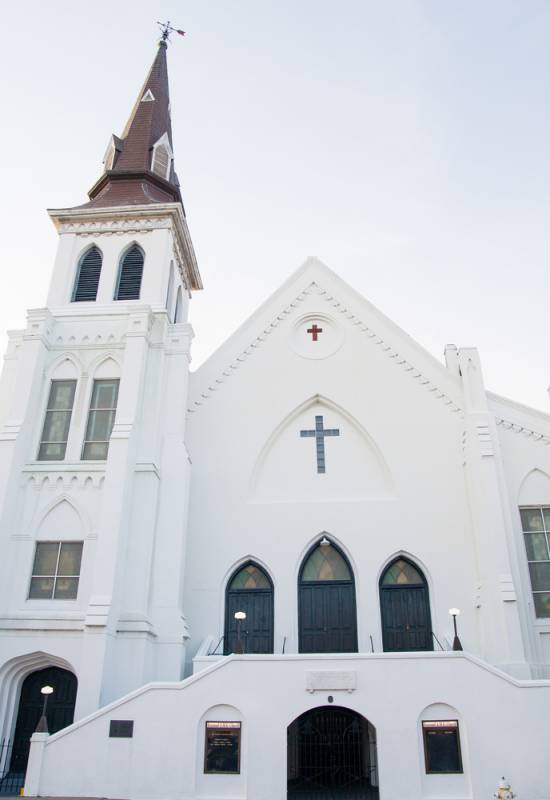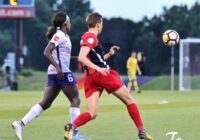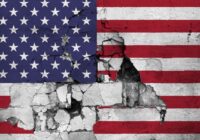As the dust settles in South Carolina, Ethan Zuckerman argues that as long as we treat each mass shooting as an isolated tragedy, there’s nothing we can do.
When you read about Dylann Roof, think about the patterns he represents. There’s more than one.
Over the next few days, we’re going to hear about mental illness. We’re going to hear about troubled loners. We’ll hear about a young man’s racist fantasies, so outrageous that he would celebrate the apartheid regimes of South Africa and Rhodesia. We’ll hear from family, neighbors and high school friends, and the picture that will start emerging is of a young man who was strange, disturbed, sick and abnormal. The message will be that the massacre in Charleston was an unpredictable, unavoidable tragedy that was carried out by an individual madman.
But don’t lose sight of the patterns.
A Crime of Hate in South Carolina
When Roof shot and killed nine African Americans at a Bible study in the Emanuel African Methodist Episcopal Church in Charleston, South Carolina, it was a hate crime. We know, because Roof told the survivors precisely why he had come to this historic church to commit mass murder: “You’re raping our women and taking over the country. You have to go.”
It was an act of domestic terrorism. Roof has reportedly told investigators that he wanted to start a race war with his actions. Shooting nine black people as they prayed was a way to terrorize all black people and to destroy the safety and comfort of what should be the safest of spaces.
It was also part of a pattern.
The United States is a dangerous place to be a black person. Black Americans are twice as likely to die from gun violence as white Americans are. Hispanic and Asian Americans are less likely to die from gun violence than white Americans—gun violence is a tragedy that disproportionately affects black Americans. So too is murder. In 2012, blacks represented 13% of the US population and represented 50% of homicide victims. Black men were 8.5 times more likely to be the victim of a homicide than white men.
Politicians and commentators—notably Rudy Giuliani—are fond of pointing out that most black men who die of homicide are killed by other black men. That’s true. But it’s also true that white men are mostly killed by other white men.
Most murders—78% between 1980 and 2008—are committed by someone the victim knew well: a family member, friend or other acquaintance. Given high rates of homophily in American society, it’s not surprising that black people know—and kill—black people and white people know—and kill— white people.
What is surprising is how police handle these murders.
Tension With the Police
In New York City, the “clearance rate” for homicides with white victims is 86%. For homicides with black victims, the rate is 45%. In other words, in the majority of homicide cases in which the victim is black, the case is unsolved and the murderer remains on the streets.
And while we’re talking about the police, let’s remember that at least 101 unarmed black people were killed by law enforcement in 2014. That includes Tamir Rice, Michael Brown, Eric Garner, Akai Gurley and Darrien Hunt, but it also includes dozens you probably haven’t heard about, like Justin Griffin, a 25-year-old basketball coach who had an argument with a referee—the referee was an off-duty sheriff’s deputy, and he and another deputy beat Griffin to death.
From 2010-12, teenage black men were 21 times more likely than teenage white men to be killed by police.
We need to learn to see these patterns.
Thanks to Alicia Garza, Patrisse Cullors and Opal Tometi, we have a narrative—#blacklivesmatter—that helps draw connections between Walter Scott’s death at the hands of the police in North Charleston and the slaughter of nine of Charleston’s finest citizens at the hands of Dylann Roof. As Cullors has explained, #blacklivesmatter is not just about the death of black people at the hands of police or vigilantes:
“The media really wants to say ‘This happened in Ferguson, this happened in Baltimore, this happened in New York. Are they the same?’ Yes, they’re the same. Black people are not a monolithic group, but what we are facing is something that’s extreme—and that’s poverty, that’s homelessness, that’s higher rates of joblessness, that’s law enforcement invading our communities day in and day out—and we are uprising.”
Cullors talks about a “Black Spring,” a parallel to the Arab Spring, in which black people and their allies start uprising and demanding a more just nation. People who knew Roof tell us that he was obsessed with the protests resulting from the Trayvon Martin and Freddie Gray deaths—a Black Spring is exactly what he appears to have feared the most.
Those he killed, notably the Reverend Clementa Pinckney, who as a state senator was a key figure in the fight to bring body cameras to South Carolina police, were precisely the people working to better the lives of the black community—and the community as a whole—in Charleston, South Carolina.
It happened in South Carolina
Was Dylann Roof a troubled loner?
Yes. But he was also a resident of a state where a segregationist flag flies above the State Capitol and can’t be taken down or lowered to half-mast without approval by the state assembly. To reach the scene of his crime, he drove on highways named for Confederate generals. He lives in a country where black people are disproportionately the victims of official and unofficial violence. Dismissing him as a uniquely sick individual ignores the pattern.
Roof also lives in a nation with a unique and problematic relationship with guns. Rates of private gun ownership are higher in the US than anywhere else in the world—twice as high, for instance, as that of Yemen, a conflict-torn nation in the throes of a domestic insurgency. Our gun murder rate is off the charts: To find adequate comparisons, we need to look at countries like Iraq and the Democratic Republic of the Congo.
Not only were Dylann Roof’s crimes part of a pattern of gun violence that’s near-unique to the US, they are part of a pattern of mass shootings. Mother Jones, tracking shootings by single killers in public places in which four or more people were killed, has identified more than 70 mass shootings in the US since 1982. Like most mass killers, Roof used a handgun, and like the vast majority of mass killers, he obtained his weapon legally.
We have a pattern of mass gun killings in the US, and we have a pattern of doing nothing about them.
Two years after the massacre of elementary school students in Newtown, Connecticut, The New York Times has tracked gun laws passed in the year after the shootings. The results: 39 laws tightened gun restrictions; 70 loosened them.
If the pattern continues, South Carolina—a state where you do not need a permit to own any sort of handgun—is more likely to legalize concealed carry without a permit than it is to pass significant restrictions on handgun ownership.
We didn’t have to wait long to hear the argument that more guns would have saved lives in Charleston. Fox and Friends managed to find a pastor who argued that religious leaders should preach while armed, so that they could defend the flock from attack.
National Rifle Association (NRA) Board member Charles Cotton found a way to blame Roof’s crimes on a man he slaughtered, Reverend Pinckney: “… he [Pinckney] voted against concealed-carry. Eight of his church members who might be alive if he had expressly allowed members to carry handguns in church are dead. Innocent people died because of his position on a political issue.”
American resistance to sane gun control laws is based on fantasy. We fantasize that guns will protect us from being victims of crime. They don’t. Gun owners are five times more likely to be shot than non-owners. Women who live in a house containing one or more guns are 3.4 times more likely to be killed than women who live in gun-free homes. We fantasize that we will stop crimes with guns, if only pastors or teachers or any brave civilian were allowed to carry concealed weapons.
We’d do well to remember Joe Zamudio, a bystander at the rally where Representative Gabby Giffords was shot, who had a concealed weapon and narrowly missed killing not the gunman, but the man who wrestled the weapon away from the gunman.
These fantasies keep us from seeing the pattern. We live in a country where it’s far too easy for anyone—a disturbed individual, a criminal or an ordinary untrained citizen—to obtain a gun, and where gun violence is an endemic public health problem. People in other countries think we’re crazy.
But so long as we treat each mass shooting, each black death as an isolated tragedy, there’s nothing we can do. Look for the patterns. America’s obsession with guns is a big part of what makes this nation so dangerous for black people. America’s endemic racism is a big part of what makes Americans buy, own and lobby for guns, to protect ourselves from an “other” that we fear.
Jon Stewart did a wise thing in reacting to the shootings in Charleston—he admitted that there were simply no jokes that could be made. But he also articulated a sense of hopelessness that’s easy to feel, and hard to fight:
“I honestly have nothing other than just sadness once again that we have to peer into the abyss of the depraved violence that we do to each other and the nexus of a just gaping racial wound that will not heal, yet we pretend doesn’t exist. And I’m confident, though, that by acknowledging it, by staring into that and seeing it for what it is, we still won’t do jack shit.”
We’ve got to do better than that. Help people see, and help us fight, these patterns.
*[This article was originally published by The Conversation.] ![]()
The views expressed in this article are the author’s own and do not necessarily reflect Fair Observer’s editorial policy.
Photo Credit: B Brown / Darryl Brooks / Shutterstock.com
 We bring you perspectives from around the world. Help us to inform and educate. Your donation is tax-deductible. Join over 400 people to become a donor or you could choose to be a sponsor.
We bring you perspectives from around the world. Help us to inform and educate. Your donation is tax-deductible. Join over 400 people to become a donor or you could choose to be a sponsor.
Support Fair Observer
We rely on your support for our independence, diversity and quality.
For more than 10 years, Fair Observer has been free, fair and independent. No billionaire owns us, no advertisers control us. We are a reader-supported nonprofit. Unlike many other publications, we keep our content free for readers regardless of where they live or whether they can afford to pay. We have no paywalls and no ads.
In the post-truth era of fake news, echo chambers and filter bubbles, we publish a plurality of perspectives from around the world. Anyone can publish with us, but everyone goes through a rigorous editorial process. So, you get fact-checked, well-reasoned content instead of noise.
We publish 2,500+ voices from 90+ countries. We also conduct education and training programs
on subjects ranging from digital media and journalism to writing and critical thinking. This
doesn’t come cheap. Servers, editors, trainers and web developers cost
money.
Please consider supporting us on a regular basis as a recurring donor or a
sustaining member.
Will you support FO’s journalism?
We rely on your support for our independence, diversity and quality.









Comment